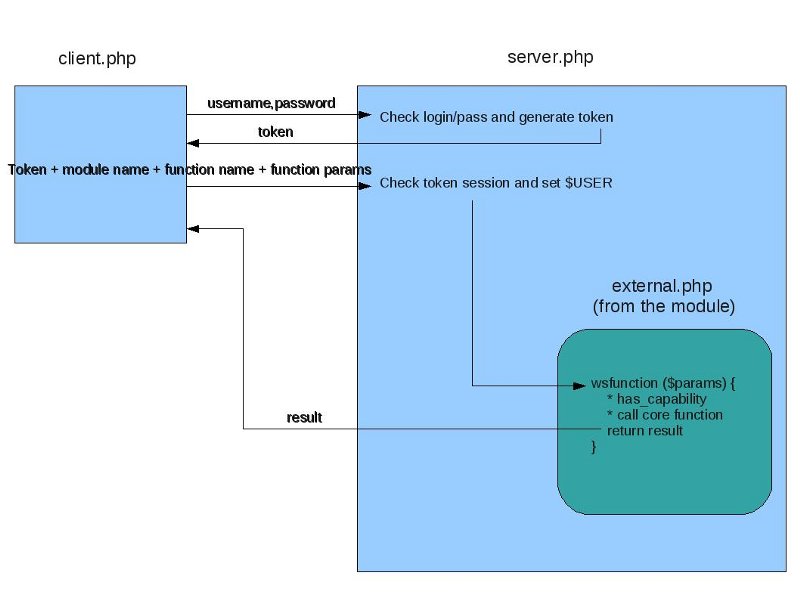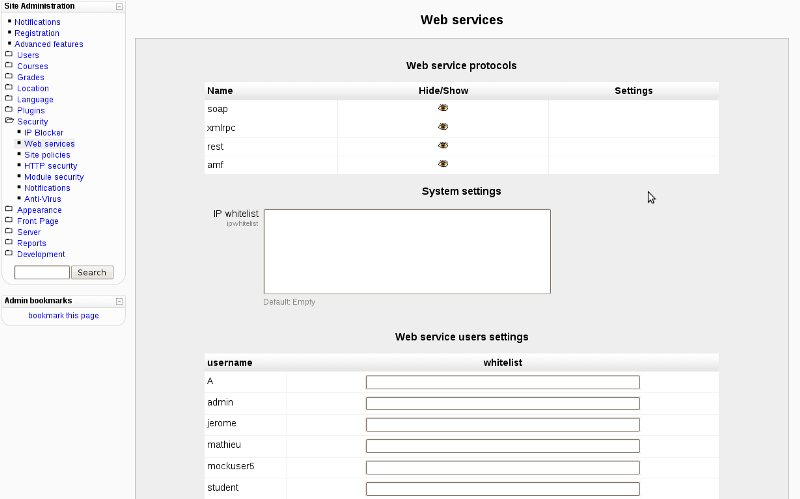Web services
Note: This page is a work-in-progress. Feedback and suggested improvements are welcome. Please join the discussion on moodle.org or use the page comments.
Moodle 2.0
Introduction
This page described the Web Services module implemented for Moodle 2.0
The tracker issue is here: MDL-12886
This module is been implemented by the DFWS Team and Moodle.
Implementation
Web Services module has been conceived in a purpose to be ported on different Moodle version, and also on different project. It has also for purpose to support multiple web service protocols (REST, SOAP, AMF, ...). Adding a new protocol support should be relatively easy.
How it works
- The client sends a username and password to the web service protocol server script.
- The protocol server returns a session token for that user account (how this is sent depends on the protocol).
- The client calls a particular web service function (module name, function name, and function parameters), including the session token.
- The protocol server uses the token to check that the session is still active.
- The protocol server call the matching external function, located in a external.php file inside the relevant module.
- The external function checks that the current user has_capability to do this operation.
- The external function calls the matching Moodle core function (in lib.php usually).
- The core function can return a result to the external function.
- The external function will return a result to the protocol server.
- The protocol server returns the result to the client.
Code example
Following some bits of code in order to explain the concept
REST_server.php
///REST params conversion
$functionname = 'delete_user' //retrieve function name from the REST parameters
$modulename = 'user' //retrieve module name from the REST parameters
$classname = $modulename.'_external';
/// Authentication process
$token = ... //retrieve token from the REST parameters
if (empty($token)) {
if ($functionname != 'generate_token') {
throw new moodle_exception('mustidentifyfirst');
} else {
///authentication + token generation
$username = ... //retrieve username from the REST parameters
$password = ... //retrieve password from the REST parameters
if ($token = generate_token($username,$password)) {
return $token;
} else {
throw new moodle_exception('wrongusernamepassword');
}
}
} else {
///the client is already identified
$user = verify_token($token);
if (empty($user)) {
throw new moodle_exception('wrongidentification');
}
else {
///Load the user in order to get its context
$USER = $user;
}
}
/// load the external class
require_once($CFG->dirroot.$apipath.'external.php');
$wsapi = new $classname();
$description = $wsapi->get_function_webservice_description($functionname); //retrieve the web service description for this function
/// retrieve all rest params in an array
$params = retrieve_rest_params ($description); //retrieve the REST params
/// call the web service function
$result = call_user_func_array ( $classname.'::'.$functionname, array($params));
/// Return the result to the client
echo convert_into_rest_format(result);
external.php
final class user_external extends moodle_external {
/**
* Constructor - We set the description of this API in order to be access by Web service
*/
function __construct () {
$this->descriptions = array();
///The desciption of the web service
///
///'params', 'optionalparams' and 'return' are used to described the web services to the end user
///(can build WSDL file from these information)
$this->descriptions['delete_user'] = array( 'params' => array('username'=> PARAM_ALPHANUM),
'optionalparams' => array( ),
'return' => array('result' => PARAM_BOOL));
/**
* Delete a user
* @global object $DB
* @param array $params
* ->username string
* @return boolean true if success
*/
static function delete_user($params) {
global $DB,$USER;
$user = $DB->get_record('user', array('username'=>$params['username']));
if (has_capability('moodle/user:delete', get_context_instance(CONTEXT_SYSTEM))) {
return delete_user($user); //this core function is in moodlelib.php
}
else {
throw new moodle_exception('couldnotdeleteuser');
}
}
}
?>
List of functions
All callable functions are declared into each external.php. A "description" array contains all function names, parameter names and types, and return type.
Authentication
Clients needing to use a web service will need a Moodle user account with the 'moodle/site:usewebservices' capability enabled. After the first login with username and password the session is retained with a token that gets passed with every web service request (until the session expires).
The Moodle administrator can control access to the site using the 'Security -> Web services' page, which contains settings for:
- enabling/disabling particular protocols (SOAP, REST, AMF, XMLRPC, ...)
- configure protocol-specific settings (though we can't think of any such settings)
- configure system-wide default settings (stored in config table):
- IP whitelist
- Anything else?
- configure per-user settings (stored in user_preferences):
- IP whitelist
- Anything else?
Each protocol will call a webservice authentication function before allowing access, which will:
- Check that particular protocol is enabled for the system
- Authenticate the user using username/password and normal auth plugins (internal, LDAP etc)
- Check that the user has 'moodle/site:usewebservices' at SYSTEM level.
- Check the per-user restrictions, if there are any, else check the system settings
- Create a session and return a token for the web service protocol to use.
This is probably enough (an auth/webservice is not necessary).

